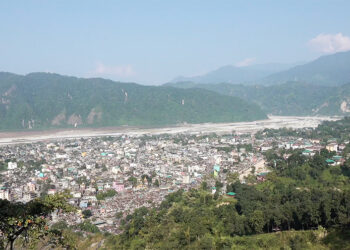
With more than 80 per cent of the works completed so far, the Nikachhu Hydropower Project in Trongsa is inching closer to the completion date, set for next year. Seeing this scale of work progress, the subsidiary company of Druk Green Power Corporation (DGPC) is confident of meeting the deadline.
Located at Lorim in Tangsibji Gewog of Trongsa, the execution works of the 118-Megawatt Nikachhu Hydropower Project began in the spring of 2016.
The project was slated for completion in the summer, last year.
However, the pandemic induced lockdowns and the intermittent supply of raw materials from India and third countries forced the project to extend the deadline.
It is also having similar problems faced by some other hydropower projects in the country.
 These are shortage of labour and poor geological hazards, prolonging the works to complete on time. Today, there are around 1,300 workers including more than 500 Bhutanese at the project site.
These are shortage of labour and poor geological hazards, prolonging the works to complete on time. Today, there are around 1,300 workers including more than 500 Bhutanese at the project site.
The dam along with three floodgates is almost complete. The floodgates are designed to regulate the flow of water from the dam.
“The first and second floodgates have been complete. The third one will be complete this summer as scheduled,” said Yeshey Wangchuk, the Chief of the dam under the Nikachhu Hydropower Project.
 The powerhouse and its two units that will have the capacity to generate 120 megawatts of electricity are nearly complete. Nozzle installation works for the two units were completed and they will regulate the water jets to generate the power.
The powerhouse and its two units that will have the capacity to generate 120 megawatts of electricity are nearly complete. Nozzle installation works for the two units were completed and they will regulate the water jets to generate the power.
The works to set up seven transformers and a few civil works in the powerhouse are underway.
But, the 12,000 metres long tunnel excavation work is posing a major challenge to the workers. The geological hazards impeded the work, yet only the portion of 240 metres is left to be excavated.
“There is no use of drilling and blasting in that tunnel. Instead, we had to do complex activities such as pipe roofing and grouting and that’s how it slowed our work progress,” added Yeshey Wangchuk.
Nonetheless, the works are targeted to be completed within the next three months.
Once complete, the hydropower project will supplement the power generation of the Mangdechhu Hydroelectric Project during the lean season.
As inked in the agreement between the Nikachhu Hydropower Project and the Power Trading Corporation of India, the electricity will be sold to India.
Close to Nu 12bn is being spent on the project, which is jointly funded by the State Bank of India, the DGPC and the Asian Development Bank.
Passang, Trongsa
Edited by Pema Lhaden






